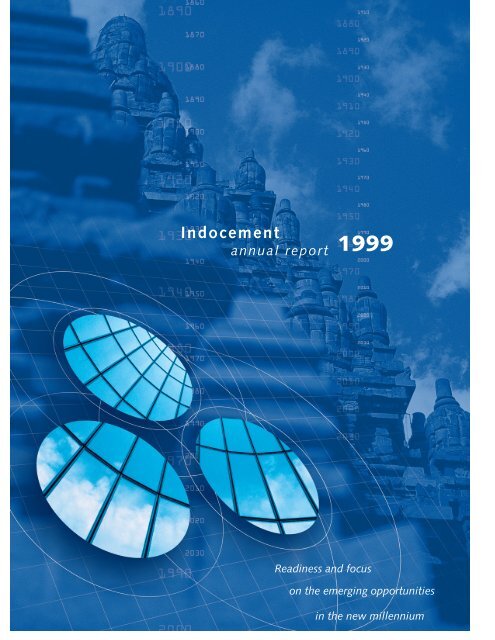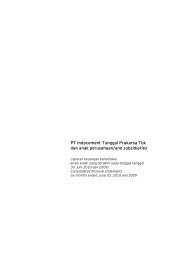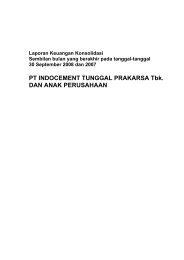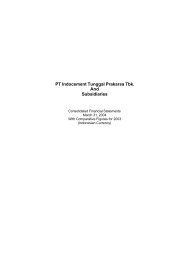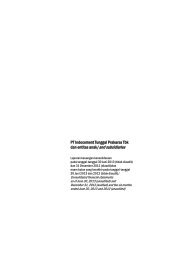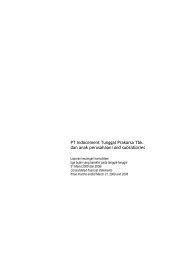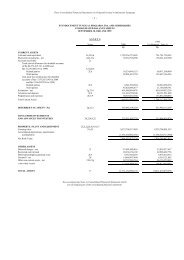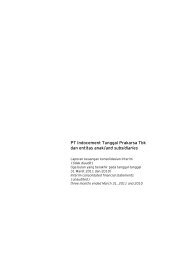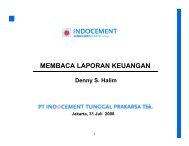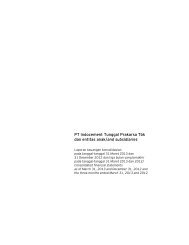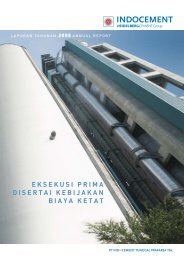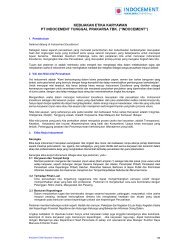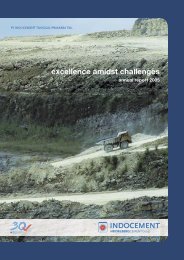Indocement Tunggal Prakarsa, PT.
Indocement Tunggal Prakarsa, PT.
Indocement Tunggal Prakarsa, PT.
Create successful ePaper yourself
Turn your PDF publications into a flip-book with our unique Google optimized e-Paper software.
<strong>Indocement</strong><br />
annual report 1999<br />
Readiness and focus<br />
on the emerging opportunities<br />
in the new millennium
Contents<br />
02 Our Mission<br />
03 Consolidated Financial Highlights<br />
04 Corporate Structure<br />
05 About the Company<br />
06 Message from the Chairman<br />
08 The Board of Commissioners<br />
11 Report to Shareholders<br />
16 The Board of Directors<br />
Review of Operations<br />
18 Marketing<br />
21 Production<br />
23 A Brief History<br />
Financial Review<br />
25 Management’s Discussion and Analysis<br />
28 Human Resources<br />
30 Environment and Community<br />
33 Other Investments<br />
34 Five Year Summary<br />
35 Stock Market Performance<br />
36 Independent Auditors’ Report<br />
80 Corporate Information
Our Mission<br />
Leadership in cement and associated core businesses<br />
• providing superior returns to shareholders, and<br />
• contributing to Indonesia's economic development.<br />
Good corporate citizenship<br />
• providing continuing opportunities for employees’ success<br />
and growth,<br />
• supporting community and environment development, and<br />
• providing opportunities for the public to participate and<br />
share in the Company's success.
Consolidated Financial Highlights<br />
Amounts in billions of<br />
Rupiah unless otherwise stated 1999 1998 % Change<br />
Restated<br />
Net revenues 1,759 1,590 11<br />
Income from operations 371 437 (15)<br />
Income (loss) before income tax 757 (1,082) 170<br />
EBITDA 1,164 (546) 313<br />
Net income (loss) 523 (634) 182<br />
Earnings (loss) per share (Rp) 217 (263) 182<br />
Net cash provided by operating activities 923 564 64<br />
Capital expenditures 189 1,783 (89)<br />
Total assets 9,851 9,641 2<br />
Net indebtedness 7,362 8,337 (12)<br />
Total shareholders’ equity 1,126 665 69<br />
Market capitalization as of 31 December 7,485 7,666 (2)<br />
Foreign exchange gain/(loss) 527 (1,082) 149<br />
Financial ratios (%)<br />
Net gearing 530 1,131 (53)<br />
Interest cover (times) 4.0 (1.8) 318<br />
I N D O C E M E N T A N N U A L R E P O R T 1 9 9 9 C o n s o l i d a t e d F i n a n c i a l H i g h l i g h t s<br />
03<br />
Debt to equity 505 805 (37)<br />
Return on equity 47 (95) 149
Corporate Structure<br />
<strong>PT</strong> INDOCEMENT TUNGGAL PRAKARSA Tbk.<br />
CEMENT BUSINESS<br />
Cement Manufacturing<br />
<strong>PT</strong> <strong>Indocement</strong> <strong>Tunggal</strong> <strong>Prakarsa</strong> Tbk. 100.0%<br />
Citeureup – 9 Plants<br />
<strong>PT</strong> <strong>Indocement</strong> <strong>Tunggal</strong> <strong>Prakarsa</strong> Tbk. 100.0%<br />
Cirebon – 2 Plants<br />
<strong>PT</strong> Indo Kodeco Cement 72.1%<br />
(Thru <strong>PT</strong> <strong>Indocement</strong> Investama)<br />
South Kalimantan – 1 Plant<br />
Others<br />
<strong>PT</strong> Indomix Perkasa 100.0%<br />
Ready Mix Concrete<br />
<strong>PT</strong> Indo Clean Set Cement 47.5%<br />
Clean Set Cement<br />
<strong>PT</strong> Dian Abadi Perkasa 51.0%<br />
Cement Trading<br />
OTHER INVESTMENTS<br />
Offices & Hotels<br />
<strong>PT</strong> Wisma Nusantara International 33.9%<br />
Wisma Indosemen 100.0%<br />
Industrial Estates<br />
<strong>PT</strong> Cibinong Center Industrial Estate 50.0%<br />
Engineering Services<br />
<strong>PT</strong> Indotek Engico 50.0%<br />
Allied Businesses<br />
<strong>PT</strong> Indominco Mandiri 35.0%<br />
Stillwater Shipping Corporation 50.0%
About the Company<br />
The Company is one of Indonesia's premier producers<br />
of quality cement and specialty cement products. The<br />
Company has grown from a small cement plant with an<br />
annual production capacity of 0.5 million tons in 1975<br />
to a fully-integrated cement manufacturing enterprise<br />
with a total production capacity today of more than<br />
15 million tons clinker per year.<br />
The Company is listed on the Jakarta and Surabaya<br />
stock exchanges and had an annual sales revenue of<br />
approximately Rp1.8 trillion (US $ 248 million) in 1999.<br />
As a Group, the Company maintains major investments<br />
in fully-owned or controlled subsidiaries engaged in<br />
allied businesses such as coal mining, cement trading,<br />
I N D O C E M E N T A N N U A L R E P O R T 1 9 9 9 A b o u t t h e C o m p a n y<br />
05<br />
shipping, property, and technical services.<br />
At the end of 1999 the Group’s workforce numbered<br />
over 7,000 employees.
I N D O C E M E N T A N N U A L R E P O R T 1 9 9 9 M e s s a g e f r o m t h e C h a i r m a n<br />
06<br />
Message from the Chairman<br />
Board of Commissioners<br />
The race to take the lead in tapping the emerging opportunities in<br />
the new millennium has already begun<br />
1999 was a year of mixed challenges and a year of transition.<br />
The crisis in the Indonesian economy and across Asia continued to<br />
stall levels of activity in the construction sector. This undermined<br />
our earnings as domestic demand for cement remains down and<br />
export market continues to be highly competitive pushing export<br />
price to rock-bottom levels.<br />
On the other hand, although real economic impact is yet to be felt,<br />
the favorable developments in the Indonesian political situation<br />
starting with the successful democratic presidential election in June<br />
have deterred a further plunge in the Indonesian economy.<br />
The rupiah exchange rate has slightly improved and stabilized,<br />
interest rates have gone down, inflation has scaled down and<br />
indications of increasing economic activities started to appear by the<br />
latter half of the year. A similar trend is true in the Asian region<br />
where most of our export customers are based and where a number<br />
of our competitors operate. All these mark the transition in 1999<br />
from a period of uncertainties to a period of hope for the cement<br />
industry. Now, the race to take the lead in tapping the emerging<br />
opportunities in the new millennium has begun. We will stay focused<br />
and ready to perform despite the economic difficulties.<br />
Our strategic purpose is clear: We will sharpen our focus on<br />
emerging opportunities, and forge ahead to establish solid<br />
foundations for optimum returns for the Company<br />
For the Company’s part, the initiatives we took and the on-going<br />
programs we have implemented, tempered the effect of the crisis as<br />
we passed through very difficult times. The significant stride we<br />
made and which we are about to complete toward the successful restructuring<br />
of our loans and the positive inroads to forge alliances<br />
with strategic investors shall, in time, transform your Company’s<br />
position from uncertain to confident. Now, our strategic purpose is<br />
clear: We will sharpen our focus on the emerging opportunities, and<br />
forge ahead to establish solid foundations for optimum returns for<br />
the Company.<br />
Our principal challenges remain in optimizing sales, enhancing<br />
distribution, improving productivity and efficiency, and lowering
operating costs in order to regain competitive strength. With new<br />
technologies that improve quality and increase productivity,<br />
competence development is an increasingly important factor.<br />
Ongoing developments in our business organization and human<br />
resources are targeted to ensure that a large number of specialized<br />
skills combine effectively to achieve established goals.<br />
With our core competencies anchored on our state-of-the-art<br />
production facilities, highly committed work force and efficient<br />
supporting infrastructure, I am confident of the continued success of<br />
the Company as in past years. It may take some time before we are<br />
back to the level of profitability and sustained growth we had prior to<br />
the crisis, but the course has been set and positive indications are in<br />
line with our objectives.<br />
We remain confident that the Indonesian economy will continue to<br />
propel stability and improvement in business conditions as sound<br />
macro-economic fundamentals are eventually put in place.<br />
Management and staff continue to work together as an effective team<br />
focused on the Company's strategic aims and tackling today's<br />
challenges with greater dedication and vigor. Together with the<br />
continuing support of our valued customers, suppliers, bankers and<br />
of our shareholders, your Company is ready to march onward to the<br />
new millennium with greater determination to succeed.<br />
As we passed another eventful year, we grieve the demise of<br />
Mr. H. Aang Kunaefi, our colleague on the Board of Commissioners.<br />
We treasure his wisdom, his zeal and dedication to the Company.<br />
We heartily welcome Mr. I Ketut Mardjana, a new member of the<br />
Board of Commissioners.<br />
I N D O C E M E N T A N N U A L R E P O R T 1 9 9 9 M e s s a g e f r o m t h e C h a i r m a n<br />
07<br />
In closing, we extend our deepest appreciation to all our employees<br />
for their hard work and commitment throughout the year. We thank<br />
our valued customers, suppliers, bankers, and shareholders for your<br />
continuing support, faith and confidence.<br />
Soedono Salim<br />
President Commissioner
Sutanto Djuhar<br />
Johny Djuhar<br />
Soedono Salim<br />
I N D O C E M E N T A N N U A L R E P O R T 1 9 9 9 T h e B o a r d o f C o m m i s s i o n e r s<br />
08<br />
I Ketut Mardjana<br />
Tanto Koeswanto<br />
Andree Halim<br />
The Board of Commissioners<br />
The Board of Commissioners is responsible for overseeing the<br />
activities of the Board of Directors. Commissioners may examine the<br />
Company’s books, records and documents and have the power to<br />
temporarily suspend any Director in case of breach of the Articles of<br />
Association, neglect of his obligations, or failure to act in the best<br />
interest of the Company. Approval by at least three Commissioners is<br />
required for actions taken on behalf of the Company including<br />
borrowing money, granting guarantees, acquiring or disposing of<br />
fixed assets, and establishing subsidiaries.<br />
Kuntara
Soedono Salim, 83<br />
President Commissioner<br />
Mr. Salim has been President Commissioner of <strong>Indocement</strong> since 1985.<br />
He is one of the Company founders, as well as founder and Chairman<br />
of the Salim Group. He is also a Commissioner of several related<br />
companies. He was awarded the Dean’s Medal by the University of<br />
Pennsylvania’s Wharton School of Finance in 1996.<br />
Sutanto Djuhar, 71<br />
Commissioner<br />
Mr. Djuhar has been a Commissioner of <strong>Indocement</strong> since 1985 and<br />
was one of its founders. He is a business partner of Mr. Soedono Salim.<br />
Johny Djuhar, 41<br />
Commissioner<br />
Mr. Djuhar, a son of Mr. Sutanto Djuhar, has been a Commissioner of<br />
<strong>Indocement</strong> since 1993.<br />
Kuntara, 60<br />
Commissioner<br />
Mr. Kuntara has been a Commissioner of <strong>Indocement</strong> since 1994.<br />
Andree Halim, 52<br />
Commissioner<br />
Mr. Halim, a son of Mr. Soedono Salim, has been a Commissioner of<br />
<strong>Indocement</strong> since 1995. He is Vice Chairman of the Salim Group.<br />
Tanto Koeswanto, 59<br />
Commissioner<br />
Mr. Koeswanto was appointed as a Commissioner of <strong>Indocement</strong> in<br />
June 1997.<br />
I Ketut Mardjana, 49<br />
Commissioner<br />
Mr. Mardjana was appointed as a Commissioner of <strong>Indocement</strong> in<br />
August 1999. He received his PhD degree from Monash University,<br />
Melbourne, Australia.<br />
I N D O C E M E N T A N N U A L R E P O R T 1 9 9 9 T h e B o a r d o f C o m m i s s i o n e r s<br />
09
Report to Shareholders<br />
• Consolidated net income before tax turned around to<br />
Rp757 billion from a net loss of Rp1,082 billion in 1998.<br />
• Cash flow provided by the operations amounted to Rp923<br />
billion, 1.6 times last year’s figure of Rp564 billion.<br />
• Export sales rose by 80 percent to 2.2 million tons,<br />
providing cash generation of US$39 million.<br />
Dear Shareholders,<br />
This year marked a significant transition for your Company from the<br />
harsh realities of the Asian economic crisis.<br />
Consolidated net income before income tax turned around to Rp757<br />
billion from a net loss of Rp1,082 billion in 1998. This was brought<br />
about mainly by foreign exchange gain arising from the restatement<br />
of foreign denominated loans using an end-of-the-year middle rate of<br />
Rp7,100 per one US dollar compared to Rp8,025 applied at the end<br />
of last year.<br />
Consolidated gross profit rose 3 percent to Rp635 billion compared<br />
to Rp616 billion in 1998. However, consolidated income from<br />
operations dropped 15 percent to Rp371 billion from Rp437 billion<br />
last year .<br />
Cash flow provided by operations amounted to Rp923 billion,<br />
an improvement of Rp359 billion compared to the previous year.<br />
The return on equity, rebounded to positive 47 percent from a<br />
negative of 95 percent.<br />
I N D O C E M E N T A N N U A L R E P O R T 1 9 9 9 R e p o r t t o S h a r e h o l d e r s<br />
11<br />
OPERATING HIGHLIGHTS<br />
Export sales volume nearly doubled the previous year's level as<br />
successful market penetration strategies made inroads to additional<br />
markets in Asia, Africa and the Middle East.<br />
Recognizing that the marketing of our cement both locally and<br />
abroad requires continuing improvement and would necessitate<br />
significant effort and commitment, we have started the restructuring<br />
of our marketing organization to be able to concentrate more<br />
on development and sales, as well as a strengthened presence in<br />
both markets.
I N D O C E M E N T A N N U A L R E P O R T 1 9 9 9 R e p o r t t o S h a r e h o l d e r s<br />
12<br />
The average selling price for both domestic and export sales during the<br />
year rose to Rp250,685 per ton of cement from Rp211,860 last year<br />
brought about mainly by gradual adjustments in the price of cement in<br />
the domestic market. Total sales volume for the year was 8.6 million<br />
tons, 13 percent higher than last year.<br />
As dictated by market demand, production capacity utilization<br />
remained low at 56 percent vis-a-vis the increased capacity. This<br />
effectively pushed our production costs to rise above the level we<br />
achieved as a result of our successful cost containing efforts.<br />
Production costs and operating expenses increased by 20 percent to<br />
Rp1,388 billion from Rp1,153 billion in 1998 as the effects of the<br />
economic crisis continued to influence higher cost of raw materials,<br />
spare parts, supplies and overheads. We have maintained our existing<br />
workforce and increased salaries and related costs while sustaining<br />
manpower benefits and community commitments.<br />
Interest charges declined by Rp128 billion or by approximately 34<br />
percent from last year’s Rp383 billion due to lower composite interest<br />
and exchange rates.<br />
STATUS OF MAJOR UNDERTAKINGS<br />
Plant 11 Construction and supporting major capital expenditures<br />
Through careful planning and prudent management, we pursued our<br />
plans and projects against the odds and the negative developments in<br />
the economy.<br />
The construction of Plant 11 was completed and trial operations<br />
started in March 1999 providing additional production volume of over<br />
0.8 million tons of cement during the year. Major supporting projects<br />
to align our infrastructure for enhanced production capacity has<br />
likewise been completed during the year. Total cash outlay for capital<br />
projects during the year was Rp189 billion compared to Rp1,783<br />
billion in the previous year. This includes Rp56 billion and Rp21<br />
billion for mining and power plant improvement projects, respectively.
Loan-restructuring and investor alliance<br />
Substantial progress developed in our debt restructuring negotiations<br />
having reached an agreement with the Steering Committee as provided<br />
for on the "term sheet". The detailed implementing terms and<br />
conditions have been presented to all creditors to obtain their<br />
concurrence. Once approved by the creditors and the Company,<br />
implementing the terms of the restructuring arrangement will, in time,<br />
bring the Company back to a stronger financial position while<br />
enhancing its readiness to face competition.<br />
Negotiations to forge an alliance with foreign investors are nearing<br />
completion. The successful completion of this initiative complements<br />
our strengthened financial position and enhances our capability to<br />
optimize exports.<br />
Y2K Update<br />
Transition to the New Millennium has been smooth and free from<br />
Y2K problems. Our Y2K preparedness ensured the continuity of our<br />
operation, the dependability of our record and the reliability of our<br />
reporting systems. A number of other projects have been lined up to<br />
improve our internet and intranet connections and make necessary<br />
information readily available to intended users.<br />
The implementation of the cement production online system from raw<br />
mill to packaging pertaining to our 11 plants located at Citeureup and<br />
Cirebon was successfully completed. We have made enhancements and<br />
modifications to suit the unique nature of each plant, integrated to our<br />
existing computer systems.<br />
The system provides online hourly update monitoring and viewing of<br />
cement operations, including the raw material consumption using a<br />
standard formula and can be accessed directly by Head Office. It also<br />
provides an hourly update of stock information of all cement plants<br />
and cement terminals.<br />
I N D O C E M E N T A N N U A L R E P O R T 1 9 9 9 R e p o r t t o S h a r e h o l d e r s<br />
13
I N D O C E M E N T A N N U A L R E P O R T 1 9 9 9 R e p o r t t o S h a r e h o l d e r s<br />
14<br />
BUSINESS OUTLOOK FOR YEAR 2000 AND BEYOND<br />
With the Indonesian economy improving with a GDP growth of<br />
0.23 percent in 1999 compared to negative 13.2 percent in 1998,<br />
interest rates tapering off and business conditions starting to<br />
improve, the cement industry is now at the threshold of a recovery.<br />
The easing of our financial burdens and ultimate stabilizing of our<br />
financial condition combined with our strategies in the context of<br />
prevailing conditions will underpin and promote the Company's<br />
thrust to regain market leadership and growth towards the year 2000<br />
and beyond.<br />
Our continuing challenges will be to remain strong in enhancing our<br />
market position, ensuring competitive pricing and excellent<br />
distribution. Improving operational efficiency and maintaining costcompetitiveness<br />
alongside high quality product and services are<br />
company strengths that will continue to develop.<br />
Strategic Thrusts<br />
Our strategic thrust is to penetrate more effectively our main<br />
market, tapping opportunities as they emerge. We have revisited our<br />
strategy and conducted a broad re-examination of our capabilities to<br />
be able to address more effectively areas we need to improve on and<br />
to grow our strengths. Adjustments will have to be made in the way<br />
we manage and do business to ensure our success.<br />
We will continue to focus our technological and managerial<br />
strengths to areas where we believe we can add the most value and<br />
pursue new opportunities within our core competencies to bring<br />
your Company to a higher level of growth. We will continuously<br />
take a hard look at all operations and human resources to ensure<br />
they remain efficient and effective.<br />
As we continue to face challenges that fully test our capabilities,<br />
we place greater importance on the value of our human<br />
resources... our people<br />
Backed up by our employees’ skills, hard work and dedication, we<br />
are confident that we will be able to capitalize on the many<br />
opportunities ahead. We will continue to support community<br />
development and fulfill our role as a good corporate citizen.<br />
Once again, we thank our valued customers, employees and<br />
shareholders for their continuing faith and support during this<br />
difficult period.<br />
Jakarta, April 20, 2000
Board of Commissioners<br />
Soedono Salim<br />
Johny Djuhar<br />
Andree Halim<br />
Sutanto Djuhar<br />
Kuntara<br />
Tanto Koeswanto<br />
Board of Directors<br />
Sudwikatmono<br />
Ibrahim Risjad<br />
Iwa Kartiwa<br />
Anthony Salim<br />
Tedy Djuhar<br />
Soepardjo<br />
I N D O C E M E N T A N N U A L R E P O R T 1 9 9 9 R e p o r t t o S h a r e h o l d e r s<br />
15<br />
I Ketut Mardjana<br />
Daddy Hariadi<br />
Franciscus Welirang<br />
Benny S . Santoso
Iwa Kartiwa<br />
Franciscus Welirang<br />
Benny S. Santoso<br />
Tedy Djuhar<br />
Soepardjo<br />
Daddy Hariadi<br />
Anthony Salim<br />
Ibrahim Risjad<br />
Sudwikatmono<br />
The Board of Directors<br />
The Board of Directors is responsible for day-to-day management of the<br />
affairs of the Company. Its members are elected by the shareholders for a<br />
term of five years. <strong>Indocement</strong>’s Articles of Association provide that the<br />
Company shall have a maximum of nine Directors, including one President<br />
Director and one Vice President Director.<br />
Sudwikatmono, 65<br />
President Director<br />
Mr. Sudwikatmono is one of the founders of <strong>Indocement</strong> and has been<br />
President Director of the Company since 1985. He is also a Director<br />
of First Pacific Company Limited and a Commissioner of <strong>PT</strong> Indomobil<br />
Sukses International Tbk. In addition, he serves on the boards of several<br />
Indonesian companies involved in property development, fishery and<br />
chemical businesses.<br />
Anthony Salim, 50<br />
Vice President Director<br />
Mr. Salim, a son of Mr. Soedono Salim, has been Vice President Director<br />
of <strong>Indocement</strong> since 1989. He is also the President and Chief Executive<br />
Officer of the Salim Group and a Director of First Pacific Company<br />
Limited. He serves on the boards of a number of Indonesian companies<br />
engaged in the financial, agricultural and automotive businesses.
Ibrahim Risjad, 65<br />
Director<br />
Mr. Risjad is one of the founders of <strong>Indocement</strong> and has been a<br />
Director of the Company since 1985. In addition, he is a Director of<br />
First Pacific Company Limited and a Vice President Commissioner<br />
of <strong>PT</strong> Indofood Sukses Makmur Tbk. He is actively involved in a<br />
number of Indonesian companies engaged in the property<br />
development, shipping and packaging businesses.<br />
Tedy Djuhar, 48<br />
Director<br />
Mr. Djuhar, a son of Mr. Sutanto Djuhar, received his B.A. degree<br />
from the University of New England and has been a Director of<br />
the Company since 1985. He is also a Director of First Pacific<br />
Company Limited.<br />
Iwa Kartiwa, 58<br />
Director<br />
Mr. Kartiwa has been a Director of <strong>Indocement</strong> since 1985.<br />
Before joining the Company, he was a Director of <strong>PT</strong> Semen<br />
Baturaja.<br />
Soepardjo, 70<br />
Director<br />
Mr. Soepardjo, a retired Army General, has been a Director of<br />
<strong>Indocement</strong> since 1985. He is the Chairman of the Indonesian<br />
Cement Association.<br />
Daddy Hariadi, 53<br />
Director<br />
Mr. Hariadi has been a Director of the Company since 1985.<br />
He is also the President Commissioner of <strong>PT</strong> Citra Marga<br />
Nusaphala Persada Tbk.<br />
I N D O C E M E N T A N N U A L R E P O R T 1 9 9 9 T h e B o a r d o f D i r e c t o r s<br />
17<br />
Franciscus Welirang, 48<br />
Director<br />
Mr. Welirang has been a Director of <strong>Indocement</strong> since 1993.<br />
He is also a Director of <strong>PT</strong> Indofood Sukses Makmur Tbk.<br />
Benny S. Santoso, 42<br />
Director<br />
Mr. Santoso has been a Director of the Company since 1994.<br />
Remuneration<br />
The total remuneration of the Board of Commissioners and the Board of<br />
Directors amounted to Rp9.643 billion in 1999.
Review of Operations<br />
I N D O C E M E N T A N N U A L R E P O R T 1 9 9 9 R e v i e w o f O p e r a t i o n s<br />
18<br />
MARKETING<br />
Sales and market share<br />
In 1999, the Indonesian construction sector remained stagnant, with a<br />
slight contraction of national cement consumption. This was reflected<br />
by the Tiga Roda cement market share of 32.4 percent in 1999.<br />
With the operation of Indo Kodeco plant in South Kalimantan, we<br />
have the flexibility to shift the cement supply from Citeureup plants to<br />
IKC plant. This will strengthen our market share in the eastern part<br />
of Indonesia.<br />
Our strategy to boost export sales delivered satisfactory results.<br />
The export sales increased from 1.2 million tons in 1998 to 2.2 million<br />
tons in 1999. This export sales volume was spread out to several<br />
countries including Asia, Africa and the Middle East.<br />
Strong brand recognition and constant product quality, combined with<br />
successful marketing initiatives have bolstered our competitive leverage<br />
to increase sales within 2 years. We have reconfigured our marketing<br />
organization to enhance our focus and to strengthen our position to be<br />
one of the strongest market players in the region.<br />
Total domestic and export sales increased by 13<br />
percent, to reach 8.6 million tons from 7.6<br />
million tons in 1998.<br />
Price review<br />
The increase in the domestic price of<br />
cement effected in December 1998, followed<br />
by gradual adjustments during 1999 has<br />
impacted the substantial rise in the average price<br />
of Rp286,982 per ton in 1999 compared<br />
to Rp210,979 per ton in 1998.<br />
Export prices during 1999<br />
remained hard-pressed by stiff<br />
competition and vulnerable to<br />
foreign exchange fluctuations of<br />
the rupiah.
Market Share 1999<br />
I N D O C E M E N T A N N U A L R E P O R T 1 9 9 9 R e v i e w o f O p e r a t i o n s<br />
20<br />
21.98% Domestic - <strong>Indocement</strong><br />
45.94% Domestic - Others<br />
7.57% Export - <strong>Indocement</strong><br />
24.51% Export - Others<br />
Market Share 1998<br />
26.59% Domestic - <strong>Indocement</strong><br />
54.71% Domestic - Others<br />
5.04% Export - <strong>Indocement</strong><br />
13.66% Export - Others<br />
Product portfolio<br />
During the year, we launched Pozzolan Cement<br />
under the same Tiga Roda brandname.<br />
The market responded favorably above our<br />
expectations with sales of around 300<br />
thousand tons during the year.<br />
Ordinary Portland Cement<br />
(OPC) stays as our principal<br />
product accounting for more<br />
than 90 percent of total sales<br />
volume. Specialty cement products<br />
composed of White Cement,<br />
Oil Well Cement, Type II and Type V.<br />
Cement remain in our product portfolio serving the regular needs of<br />
specific market segments. Combined sales volume for these products<br />
dropped slightly during the year owing to lower demand.<br />
Ready-mix Concrete production was scaled down owing to<br />
significant drop in demand as some construction activities in Jakarta<br />
and West Java were either completed or discontinued during the<br />
year. The industrial construction sector, which is the principal<br />
customer for ready-mix concrete is yet to resume activities, due to<br />
financial constraints.<br />
In terms of domestic sales mix, bagged and bulk cement sales ratio<br />
during the year increased in favor of bagged cement to 95:5<br />
compared to 93:7 in 1998. This indicates a faster phase of recovery<br />
in the domestic direct consumers market outside Jakarta and<br />
West Java.<br />
Industry outlook<br />
Opportunities are emerging on two fronts: The recovering domestic<br />
market indicates gradual increase in demand as the Indonesian<br />
economic and political conditions improve and the increasing<br />
potential of Indonesian cement in the export market.
Key issues and challenges to achieve our goals on both fronts have<br />
been identified and appropriate measures put in motion. Initial<br />
results indicate that we are on the right track.<br />
We have updated our strategies, reassessed our core competencies<br />
and enhanced our readiness, focusing on our collective efforts to<br />
optimize our gains as opportunities emerge.<br />
We have learned much through our survival of the most difficult<br />
times and are determined to move ahead with confidence in our<br />
greater resilience and competence.<br />
PRODUCTION<br />
Including IKC and Plant 11, total production for the year was 7.6<br />
million tons of cement and 8.4 million tons of clinker, a slight<br />
increase from last year’s 7.1 million tons and 7.3 million tons of<br />
cement and clinker, respectively. Capacity utilization remained low at<br />
56 percent compared to an equivalent of about 58 percent last year,<br />
based on current total production capacity including Plant 11.<br />
The continuing low demand for cement impeded our capability to<br />
run at full capacity resulting in a reduced efficiency and effectively<br />
higher production cost.<br />
Trend of Bagged vs Bulk Cement Sales<br />
I N D O C E M E N T A N N U A L R E P O R T 1 9 9 9 R e v i e w o f O p e r a t i o n s<br />
21<br />
Bagged Sales<br />
100<br />
Bulk Sales<br />
80<br />
60<br />
40<br />
20<br />
0<br />
1995 1996<br />
1997 1998 1999
I N D O C E M E N T A N N U A L R E P O R T 1 9 9 9 R e v i e w o f O p e r a t i o n s<br />
22<br />
Previous investments to improve our production and support facilities<br />
continued to provide the intended benefits in terms of lower energy<br />
consumption, improved production process and lower overhead costs<br />
The waste heat recovery system implemented several years ago<br />
continued to yield substantial savings in power generation cost.<br />
The central power control system developed last year provided<br />
adequate protection to our plant's manufacturing equipment against<br />
costly breakdown in the event of power failure.<br />
We have completed the cooler modification projects for Plant 7<br />
resulting in improved production efficiency and sustained product<br />
quality. Completing the major modification projects for our mining<br />
facility in the Citeureup production complex during the year<br />
also enhanced our capability to supply a consistent quality of<br />
raw materials.<br />
On March 1, 1999, the kiln of P11 was fired and a trial operation<br />
was successfully performed. The P11 project was executed during<br />
the economic downturn and political instability, however the project<br />
was completed as originally scheduled. Certain improvements and<br />
modifications are still to be undertaken before commercial operation<br />
starts in early 2000.<br />
In addition, the completion of P11 gives us the flexibility to run only<br />
those efficient plants to minimize energy consumption. The effort to<br />
reduce energy consumption in plants that are not efficient has given<br />
us positive results. The total average heat consumption for plants<br />
that are in working operation improved by about 34 Kcal/kg clinker.
A BRIEF HISTORY<br />
Year Plant/Location Product † Production Capacity<br />
(in thousand tons of clinker per year)<br />
1975 Plant 1/Citeureup OPC 640<br />
1976 Plant 2/Citeureup OPC 534<br />
1979 Plant 3/Citeureup OPC 1,024<br />
1980 Plant 4/Citeureup OPC 1,024<br />
Plant 5/Citeureup OWC/WHC 214<br />
1983 Plant 6/Citeureup OPC 1,472<br />
1984 Plant 7/Citeureup OPC 1,760<br />
Plant 8/Citeureup OPC 1,520<br />
1991* Plant 9/Palimanan OPC 1,216<br />
1996 Plant 10/Palimanan OPC 1,216<br />
1998 Indo Kodeco plant/ OPC 2,400<br />
South Kalimantan<br />
1999 Plant 11/Citeureup OPC 2,400<br />
TOTAL 15,420<br />
† OPC: Ordinary Portland Cement, OWC: Oil Well Cement, WHC: White Cement<br />
*by acquisition<br />
1985 The birth of <strong>PT</strong> <strong>Indocement</strong> <strong>Tunggal</strong> <strong>Prakarsa</strong> Tbk. as a newly formed and<br />
strengthened holding company after the merger of six companies owning<br />
each of the first eight cement plants.<br />
1989 The Company went public, listing its shares on the Jakarta Stock Exchange.<br />
1991 Constructed Surabaya Cement Terminal and launched Ready Mix Concrete<br />
Product business.<br />
1992 Diversified business through the acquisition of a controlling stake in Indofood<br />
and Bogasari, Indonesia's leading food and flour companies. In the same year<br />
acquired Wisma Indosemen.<br />
I N D O C E M E N T A N N U A L R E P O R T 1 9 9 9 R e v i e w o f O p e r a t i o n s<br />
23<br />
1997 Divestment of Indofood and Bogasari.<br />
Production Capacity<br />
Thousand tons
Financial Review<br />
Management’s Discussion and Analysis<br />
The Company’s consolidated financial statements include those of<br />
<strong>PT</strong> Indomix Perkasa, <strong>PT</strong> Dian Abadi Perkasa and <strong>PT</strong> Indo Kodeco<br />
Cement, a 72.1 percent owned subsidiary held through<br />
<strong>PT</strong> <strong>Indocement</strong> Investama.<br />
In 1999 the Company posted a net income after tax and minority<br />
interest of Rp523 billion, including a gain on foreign exchange of<br />
Rp527 billion, vis-a-vis a net loss of Rp634 billion in 1998.<br />
The foreign exchange gain is primarily attributable to the adjustment<br />
in the exchange rate of our foreign currency debts. As a result of<br />
realizing a profit in 1999, the Company ended the year with a much<br />
stronger financial position.<br />
The consolidated net revenues increased by 11 percent, mostly from<br />
higher selling price and export sales, from Rp1,590 billion in 1998 to<br />
Rp1,759 billion in 1999, net of the sales revenue realized from<br />
Plant 11 production during the test-run period which was capitalized<br />
to construction in progress (minus corresponding cost) in conformity<br />
with generally accepted accounting practice. Against the backdrop of<br />
continuing economic difficulties, volumes and margins improved<br />
slightly across our cement products.<br />
Cost of sales and operating expenses increased by 20 percent from<br />
Rp1,153 billion in 1998 to Rp1,388 billion last year due to higher<br />
provision for bad debts and increase in production costs. The income<br />
from operations decreased by 15 percent from Rp437 billion in 1998<br />
to Rp371 billion in 1999. Other income (net of charges) increased<br />
from a net charge of Rp1,519 billion in 1998 to an income of Rp386<br />
billion in 1999. A contributing factor to the positive change was the<br />
effect of foreign exchange. In 1998 there was a significant amount of<br />
foreign exchange loss of Rp1,082 billion while in 1999 we realized a<br />
foreign exchange gain of Rp527 billion. In addition, the interest<br />
expense was down to Rp255 billion in 1999 from Rp383 billion in<br />
1998. The reduction in the interest expense was the result of the<br />
adjustment of the exchange rate from Rp8,025 to Rp7,100 in 1999.<br />
I N D O C E M E N T A N N U A L R E P O R T 1 9 9 9 F i n a n c i a l R e v i e w<br />
25
I N D O C E M E N T A N N U A L R E P O R T 1 9 9 9 F i n a n c i a l R e v i e w<br />
26<br />
Billion rupiah<br />
Billion rupiah<br />
2000<br />
1500<br />
1000<br />
500<br />
0<br />
600<br />
400<br />
200<br />
0<br />
-200<br />
-400<br />
-600<br />
-800<br />
Net revenues<br />
1,420<br />
1,449<br />
1,572<br />
1,590<br />
1,759<br />
1995 1996 1997 1998 1999<br />
Net income (loss)<br />
476<br />
551<br />
(378) (634)<br />
523<br />
1995 1996 1997 1998 1999<br />
Property, plant and equipment decreased by about<br />
1 percent or Rp48 billion from Rp8,565 billion in 1998 to<br />
Rp8,517 billion in 1999. The company limited its capital<br />
expenditures during the year to only those essential for<br />
continuity of operations and those projects which are<br />
more costly to postpone and resume construction in later<br />
years. The total capital expenditures during 1999,<br />
excluding the Plant 11 project, was Rp189 billion.<br />
The total assets of the Company increased by 2 percent<br />
from Rp9,641 billion in 1998 to Rp9,851 billion in 1999.<br />
The balance sheet was further strengthened by a groupwide<br />
effort to conserve financial resources and improve<br />
asset productivity. Current assets stood at Rp1,944 billion<br />
in 1999 from Rp1,301 billion last year, resulting in the<br />
current ratio of 0.23:1 in 1999 against 0.15:1 in 1998. At<br />
the end of the year, the Company’s cash position<br />
amounted to Rp1,024 billion, which was kept in cash, time<br />
deposits and short term investments to ensure a sufficient<br />
level of liquidity.<br />
Investment and advances to investees increased by<br />
19 percent or Rp51 billion, from Rp269 billion in 1998 to<br />
Rp320 billion in 1999. Other assets decreased by Rp56<br />
billion from Rp245 billion last year to Rp189 billion<br />
this year.<br />
Consolidated liabilities of the Company and its<br />
Rupiah<br />
300<br />
200<br />
100<br />
0<br />
-100<br />
-200<br />
-300<br />
Earnings (loss) per share<br />
197<br />
228<br />
(156) (263)<br />
217<br />
1995 1996 1997 1998 1999<br />
subsidiaries were Rp8,386 billion in 1999 as compared to<br />
Rp8,597 billion last year. The Company’s leverage profile<br />
stood at seven times to one (7X:1). A substantial portion<br />
of the Company’s borrowings is in foreign currency and is<br />
partly protected by the natural hedge provided by foreign<br />
exchange revenues from cement exports. Debt-to-equity<br />
ratio was 5:1 compared to 8:1 last year. The Company’s<br />
total interest bearing debt at the end of the year amounted<br />
to Rp6,985 billion, 10 percent lower vis-a-vis Rp7,776<br />
billion in 1998. Out of the Company’s total loans,<br />
82 percent was denominated in US dollars, 13 percent in<br />
yen and 3 percent in Italian lira and the balance in<br />
Indonesian rupiah.
Billion rupiah<br />
Billion rupiah<br />
1000<br />
800<br />
600<br />
400<br />
200<br />
0<br />
3000<br />
2500<br />
2000<br />
1500<br />
1000<br />
500<br />
0<br />
Cash generated from operations<br />
94<br />
729<br />
801<br />
564<br />
923<br />
1995 1996 1997 1998 1999<br />
Shareholders’ equity<br />
2,562<br />
1,999<br />
894<br />
665<br />
1,126<br />
1995 1996 1997 1998 1999<br />
The Company has made a substantial progress in its debt<br />
restructuring negotiations with the creditors’ steering<br />
committee. It has reached an agreement with the steering<br />
committee of its creditors on the framework of the<br />
restructuring. A definitive term sheet has been circulated<br />
to all creditors to obtain their agreement to the terms,<br />
subject to final documentation.<br />
In August 1999, the Company and its creditors reached an<br />
agreement whereby Indo Kodeco, a 72.1 percent owned<br />
subsidiary held through <strong>PT</strong> <strong>Indocement</strong> Investama,<br />
will be merged into the Company with the Company<br />
assuming the liabilities of Indo Kodeco.<br />
In October 1999, <strong>PT</strong> Mekar Perkasa, our majority<br />
shareholder, entered into an agreement with<br />
Heidelberger Zement for its prospective entry into the<br />
Company. The entry of Heidelberger into the Company<br />
will further strengthen its balance sheet and enhance the<br />
Company’s technical and operational expertise.<br />
Heidelberger is one of the largest cement companies in<br />
the world with extensive experience in cement<br />
manufacturing.<br />
Fulfilling part of its responsibilities to national<br />
development as a corporate citizen the Company has<br />
contributed a total of Rp7 billion in income taxes during<br />
the year.<br />
Shareholders’ equity amounted to Rp1,126 billion,<br />
growing from last year’s total of Rp665 billion, and<br />
earnings per share was Rp217. As of December 31, 1999,<br />
issued capital stock consisted of 2,414,453,320 shares.<br />
I N D O C E M E N T A N N U A L R E P O R T 1 9 9 9 F i n a n c i a l R e v i e w<br />
27
Human Resources<br />
I N D O C E M E N T A N N U A L R E P O R T 1 9 9 9 H u m a n R e s o u r c e s<br />
28<br />
Training, development and placement are key<br />
aspects of the Company's personnel activities<br />
Considerable changes have taken place within the<br />
Company, particularly during the past ten years–<br />
new facilities, new process technology, new<br />
information systems and changed operating<br />
environment, all of which imposed new and<br />
more rigorous demands on the personnel.<br />
However, vacancies arising from regular<br />
retirements, which have not been filled,<br />
resulted in a reduction in the number<br />
of employees.<br />
The aim of our personnel activities is to improve<br />
the efficiency of the organization and to give individual employees<br />
more stimulating tasks to encourage personal growth from within.<br />
Training and development<br />
In order to have a solid foundation on which to base personnel<br />
training and development activities, training needs are assessed<br />
throughout the organization on a fairly regular basis. Training and<br />
development programs suited to identified training needs are either<br />
developed internally or outsourced.<br />
During the past several years, our "Trainer's Training Program" in<br />
which selected employees are sent on outside training and thereafter<br />
become internal trainers within the Company yielded a deep<br />
repository of qualified trainers for our employees. This, to a large<br />
extent, provides the assimilation of knowledge and skills at a much<br />
faster pace with lesser costs.<br />
Complementary programs allow our employees mobility within the<br />
group enabling them to practice their added skills and providing<br />
them with the opportunity to harness their potential.<br />
All these programs are carefully reviewed on a regular basis and<br />
updated to keep pace with changing needs.
Our people and the future<br />
The Company recognizes human resources as the strongest<br />
link binding all its other business resources into one cohesive<br />
strand that fosters sustained success and growth<br />
The Company's long-term goal is to build the necessary broad base<br />
of manpower strengths to allow the Company to move aggressively<br />
and to continue developing and growing its business in spite of<br />
temporary downturns.<br />
The emerging realities indicate that making a difference in today's<br />
highly competitive business environment is, to a large extent,<br />
dependent on people. The significant advancements in process and<br />
information technologies help but people are still there to make the<br />
most of it.<br />
We anticipate our business to recover slowly in the next few years<br />
and eventually pick-up to new level highs. Part of our efforts today is<br />
concentrated in optimizing returns given the current conditions,<br />
sharpening our focus to detect business opportunities as they appear,<br />
and enhancing our overall readiness to tackle business challenges as<br />
they grow.<br />
The past and the present show our people's capability to make a<br />
difference. With our unique infrastructure anchored on selfsufficiency<br />
and economy of scale, the Company is confident to tackle<br />
the many challenges that lie ahead.<br />
I N D O C E M E N T A N N U A L R E P O R T 1 9 9 9 H u m a n R e s o u r c e s<br />
29
Environment and Community<br />
I N D O C E M E N T A N N U A L R E P O R T 1 9 9 9 E n v i r o n m e n t a n d C o m m u n i t y<br />
30<br />
Health, safety, community and environmental concerns are an<br />
integral part of our activities and are assessed on the same level as<br />
other operational tasks. Our first concern is to protect employees<br />
and others affected by our activities against work-related injuries and<br />
ill health.<br />
We manage our activities in such a way that strains on health,<br />
safety and environment are minimized throughout the areas where we<br />
operate. Managers at all levels are responsible for the organization,<br />
training and implementing of health, safety and environment policies and<br />
procedures, and to ensure that practices are in compliance with statutory<br />
regulations. Each employee and every individual having access to our<br />
locations are required to adhere to instructions and guidelines established<br />
for the effective implementation of these policies and procedures.<br />
Deviations are dealt with, creating a basis for corrective actions and<br />
continuous improvement.<br />
Environment<br />
The most important environmental challenges we face today are<br />
related to measures aimed at reducing dust emissions, improving<br />
waste disposal, and minimizing the impact of our operations on the<br />
local environment.<br />
The substantial capital expenditure made several years ago to equip<br />
all our plants with Electrostatic Precipitators (EP) maintains our<br />
capability to contain dust emission levels well below government<br />
mandated limits. For the past several years, our average dust<br />
emission level of 80 mg/Nm3 was much lower than the government<br />
limit of 150 mg/Nm3.<br />
Further improvements in our dust emission control at our main<br />
production facility in Citeureup enabled us to further reduce the dust<br />
fall area to 5.5 square kilometer in 1999 from 6.1 in 1998 by<br />
applying the standard “Ambient Threshold Limit” of 5 tons per<br />
square kilometer per month.
Community<br />
Despite financial difficulties, we continued to provide the funding<br />
requirements of two junior high schools now with 500 students,<br />
scholarship grants for deserving children of 350 employees, and<br />
education assistance to over 1,000 students under the "Foster<br />
Parents" program launched in 1987.<br />
We have upgraded our medical facility in Citeureup to accommodate<br />
the increasing number of patients over the years. Citeureup medical<br />
and clinic facility provides a 24-hour free emergency medical service<br />
to the community.<br />
We have continued to support the repairs and maintenance of<br />
various places of worship in the local communities where we operate<br />
and extended assistance for various community projects. The<br />
development of small businesses within the various communities<br />
covered by our operation, also continue to receive our support,<br />
together with other livelihood development projects.<br />
We strive to continually improve our participation and support to<br />
community development, an effort that confirms our continuing<br />
resolve to be a part of nation building.<br />
I N D O C E M E N T A N N U A L R E P O R T 1 9 9 9 E n v i r o n m e n t a n d C o m m u n i t y<br />
31
Other Investments<br />
Stillwater<br />
Shipping<br />
<strong>PT</strong> Indominco Mandiri<br />
A local coal mining company in Bontang, East Kalimantan with an<br />
annual production capacity of 3.5 million tons of coal.<br />
<strong>PT</strong> Citra Marga Nusaphala Persada Tbk.<br />
The largest public company in Indonesia engaged in toll road<br />
operation. Its shares are listed on the Jakarta Stock Exchange.<br />
<strong>PT</strong> Wisma Nusantara International<br />
Owner of Wisma Nusantara, a 30-storey Office Tower and<br />
the adjacent 300-room President Hotel.<br />
Stillwater Shipping Corporation<br />
A shipping company operating in Indonesia and Singapore with a<br />
total handling capacity of 10,000 dead-weight tons (DWT).<br />
<strong>PT</strong> Cibinong Center Industrial Estate<br />
An industrial park leasing land and building, located at the ex quarry<br />
site in Citeureup.<br />
<strong>PT</strong> Indotek Engico<br />
An engineering service company providing design and construction<br />
management services.<br />
<strong>PT</strong> Indo Clean Set Cement<br />
A joint venture company producing special cement used in road<br />
construction and building foundation, as a soil stabilizer.<br />
I N D O C E M E N T A N N U A L R E P O R T 1 9 9 9 O t h e r I n v e s t m e n t s<br />
33<br />
Other Investments<br />
Revenue for the year (amounts in billions of rupiah)<br />
Company 1999 1998<br />
<strong>PT</strong> Indominco Mandiri 478.40 449.27<br />
<strong>PT</strong> Citra Marga Nusaphala Persada Tbk. 276.14 271.18<br />
<strong>PT</strong> Wisma Nusantara International 93.54 83.59<br />
Stillwater Shipping Corporation* 29.27 38.73<br />
<strong>PT</strong> Cibinong Center Industrial Estate 8.42 9.73<br />
<strong>PT</strong> Indotek Engico 6.09 14.09<br />
<strong>PT</strong> Indo Clean Set Cement 0.33 1.18<br />
Total 892.19 867.77<br />
*Revenue in US dollars and converted at an average exchange rate of<br />
Rp7,930 in 1999 and Rp9,926 in 1998.
Five Year Summary<br />
I N D O C E M E N T A N N U A L R E P O R T 1 9 9 9 F i v e Y e a r S u m m a r y<br />
34<br />
Amounts in billions of rupiah<br />
unless otherwise stated 1999 1998 1997 1996 1995<br />
Net revenues 1,759 1,590 1,572 1,449 1,420<br />
Gross profit 635 616 668 695 701<br />
Income from operations 371 437 530 591 605<br />
EBITDA (1) 1,164 (546) 160 764 688<br />
Net income (loss) 523 (634) (378) 551 476<br />
Total assets 9,851 9,641 6,670 4,607 5,341<br />
Total liabilities 8,386 8,597 5,776 2,608 2,779<br />
Shareholders’ equity 1,126 665 894 1,999 2,562<br />
Net borrowings (2) 5,951 7,516 4,392 1,692 1,221<br />
Net cash provided by operating activities 923 564 801 729 94<br />
Capital employed 1,490 1,070 5,139 3,799 4,530<br />
Capital expenditures<br />
Fixed assets (3) 189 1,783 893 838 275<br />
Issued ordinary shares (million) 2,414 2,414 2,414 2,414 1,207<br />
Per share data (4) – [Rp]<br />
Primary earnings/(loss) per share 217 (263) (156) 228 197<br />
Dividend per share – – 150 70 120<br />
Book value per share 466 276 370 828 1,061<br />
Financial ratios (%)<br />
Current ratio 23 15 98 225 278<br />
Net gearing (5) 530 1,131 491 85 48<br />
Net borrowing to assets 60 78 66 37 23<br />
Return on assets 5 (7) (6) 12 9<br />
Return on capital employed 35 (59) (7) 15 11<br />
Return on shareholders’ equity 46 (95) (42) 28 19<br />
Number of employees 7,096 7,332 7,360 6,728 6,272<br />
(1) Earnings before interest, taxes, depreciation and amortization<br />
(2) Net borrowings is defined as long-term and short-term borrowings less cash and cash equivalent,<br />
and short term investment<br />
(3) Including construction in progress<br />
(4) Restated based on the weighted average number of shares after stock split in 1996<br />
(5) Net borrowings as a percentage of shareholders’ equity. Restated without Indofood data.<br />
The data covering 1995 and 1996 were restated to exclude Indofood.
Stock Market Performance<br />
The Company's issued and outstanding stock, totaling 2,414,453,320<br />
common shares with a par value of Rp500 per share, remained<br />
unchanged.<br />
During the year a total of 274 million shares were traded, more than<br />
twice the volume of 124 million shares traded in the previous year.<br />
The Company’s share price was relatively stable, opening at Rp3,175 per<br />
share on January 4 and closing at Rp3,100 per share on December 30,<br />
the first and the last trading days of 1999, respectively. The composite<br />
share price index at the Jakarta Stock Exchange increased from 394.5<br />
points in January 1999 to 676.9 points in December 1999.<br />
Highest and lowest share prices for the year were both recorded in<br />
January 1999 indicating a certain volatility of the stock market price with<br />
the unstable economic and political situation in Indonesia before the<br />
presidential election in June. The share price indicated some upward<br />
movement after the successful presidential election hitting a high<br />
transaction price of Rp3,900 per share in June 24 but slipped back to a<br />
low of Rp2,775 per share on November 30, 1999.<br />
The stock market outlook will, in the meantime, remain dependent on<br />
the economic and business developments during this period of transition<br />
in the Indonesian political situation. A key factor for business recovery<br />
would be the economic and political reforms in Indonesia gradually<br />
being put in place. This will restore investors’ confidence and enhance<br />
the inflow of foreign investment funds.<br />
The number of the Company’s shareholders as at December 31, 1999,<br />
was 1,453.<br />
I N D O C E M E N T A N N U A L R E P O R T 1 9 9 9 S t o c k M a r k e t P e r f o r m a n c e<br />
35<br />
ITP Market Capitalisation<br />
JSX Composite<br />
1000<br />
1999 ITP Market Capitalisation against JSX Composite<br />
10000<br />
800<br />
8000<br />
600<br />
6000<br />
400<br />
4000<br />
Points<br />
200<br />
0<br />
2000<br />
0<br />
4-Jan-99<br />
5-Feb-99<br />
5-Mar-99<br />
2-Apr-99<br />
7-May-99<br />
4-Jun-99<br />
2-Jul-99<br />
6-Aug-99<br />
3-Sep-99<br />
1-Oct-99<br />
5-Nov-99<br />
3-Dec-99<br />
30-Dec-99<br />
Billion Rupiah


